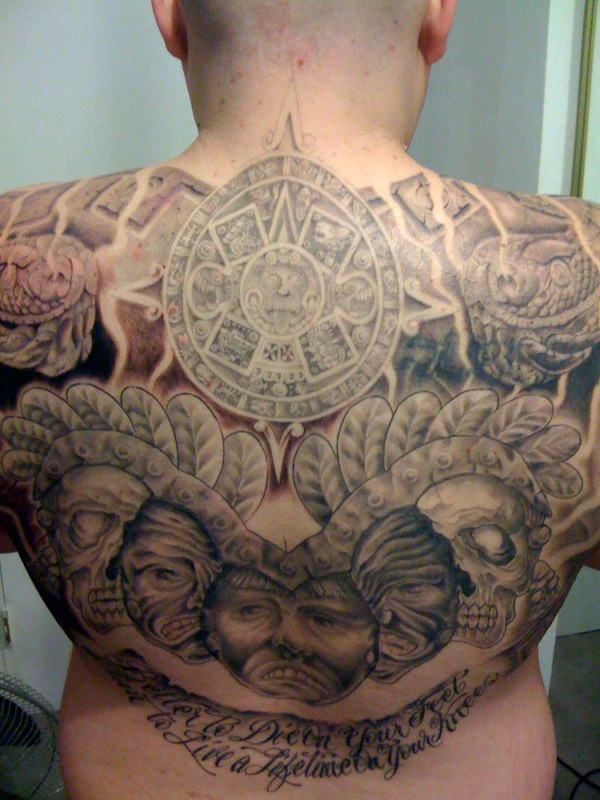
“Tattoo Nation” revealed that for many, tattoos are personal, and help tell the stories of their lives.
The film “Tattoo Nation” provides a retrospective look at how tattoo art was propelled from back alleys into the mainstream. It played Sept. 15 at SIE Film Center in Denver and was sponsored by the American Institute of Graphic Arts Colorado and ArtHouse Design. After the film, director Ed Schwartz led a discussion and fielded audience questions.
“Tattoo Nation” showed that tattoos, formerly a sign of rebellion, are fast-becoming part of mainstream culture. It estimated that 40 percent of adults 20–40 now have them. The film blended historic movie footage and iconic still images with present-day shots and interviews to show this transformation.
WWII-era tattoo design design was traditional, and modeled after comic book heroes. It used 4-color design, and those who wanted tattoos had to pick “off the wall,” where available existing designs were displayed. Schwartz estimated that in the 1960s, there were only about 300 shops in the U.S. Most of those catered to military personnel, and only a few to civilians.
Photo Credit: Grand Dame
In that climate, artists didn’t fraternize. They cranked out tattoos in almost assembly line fashion, with little creativity involved.
But things changed in the 1970s, when mostly Mexican-American artists pushed the boundaries of design and tattoo art, though they themselves were housed in prisons. To understand how this happened, we need to look at the history of these people.
Mexican-Americans were numerous in the Southwest and California, but they were ostracized by mainstream society. In the 1930s-40s, Pachuco culture developed in Mexican-American society, as a way to define its own culture and bond communities. Zoot suits and tattoos featured prominently in these communities. The result was a distinct culture, heavily influenced by family and religious values that melded with rebellious, flamboyant attitudes.
By the 70s, Pachuco culture was old school; it gave way to Cholo culture, which changed the outward look, but was still rooted in family and religious values, with a rebellious streak. Cholo culture came to be epitomized by low rider cars and fine-line, black and gray single needle tattoos. Fueled by Cesar Chavez’ “Brown Pride” movement, Chicanos became more ethnically aware.
Many, imprisoned in Texas and California created sketches to remind them of their culture and families. In prison, they began to experiment with single needle tattoos, using the e-string of a guitar and ink created from newsprint scrapings. This evolved into the hand poke single needle machine, driven by slow-running cassette player motors. Of course, these tattoos were illegal in prison, yet they flourished, and spread throughout the Chicano communities when the men left prison.
It didn’t take long before people like Charlie Cartwright, Freddy Negrete and Jack Rudy took notice. Tattoo art and design began to emerge from back alleys and into the streets.
In the 70s, Charlie Cartwright opened his shop, Good Time Charlie’s Tattooland in East L.A., on Whittier Boulevard, right in the heart of Cholo culture. He was later joined by Jack Rudy, and there, the two changed the way fine-line black and gray tattoos looked. The result was a softer design, with many shades of gray and black that blended seamlessly into other images.

Fine-line black and gray tattoo photo credit: Creative Commons user mytat_2s.
Their work drew the attention of Ed Hardy, whose own work was pushing the boundaries of color and concept by incorporating aspects of Japanese large-format tattoo art. Though from vastly different backgrounds, Hardy, Cartwright and Rudy formed a creative bond that took black and gray style tattoo to a new level.
Hardy bought Cartwright’s shop, but the three collaborated to push the boundaries of technique and design.
Goodtime Charlie’s was located in the midst of street culture. Many of its patrons lived life fast and hard, close to death. Thus, they chose images that elevated, often of religious iconography or family members. This demand for personalized design work fueled the creativity of tattoo art design. Artists like Freddy Negrete joined the party, and friendly competition ensued, which led the artists to push the boundaries of design even further.
The result was that a beautiful art form emerged from the midst of repression and gang violence. These tattoos told the story eloquently, so much so, that fine-line black and gray tattoo has now broken into mainstream society, worldwide.
In 1981, MTV brought Chicano culture to young viewers, who gobbled it up. Hardy published a magazine in the early 80s and tattoos began to pop up in suburban America. By ’84, gang violence escalated enough to make Goodtime Charlie’s relocate to Orange County.
Ink reality shows carried black and gray into people’s living rooms, driving them to come to tattoo artists with conceptual art because they want fine art on their skin.
After the film, Schwartz talked with the audience, saying that the project started as a still photography project, called “The Tattooed.” He said he spent five years making the film and struggled at first to gain the trust of Chuco leaders.
Black and gray tattoo really is street art — art of the people, Schwartz said. Thus, its design was organic, birthed out of a movement and a culture struggling to adapt.
“Really good art comes from the heart,” Schwartz said.
He shared this advice for designers, “Do stuff that you really believe in,” he said. “People are gonna’ express themselves one way or another.”
Perhaps part of the takeaway for aspiring designers is that we may need to make some difficult choices, and turn down some work, if it doesn’t align with our personal passion. And, that it’s important to always carve out space to pursue those design projects that we personally believe in.


You must be logged in to post a comment.